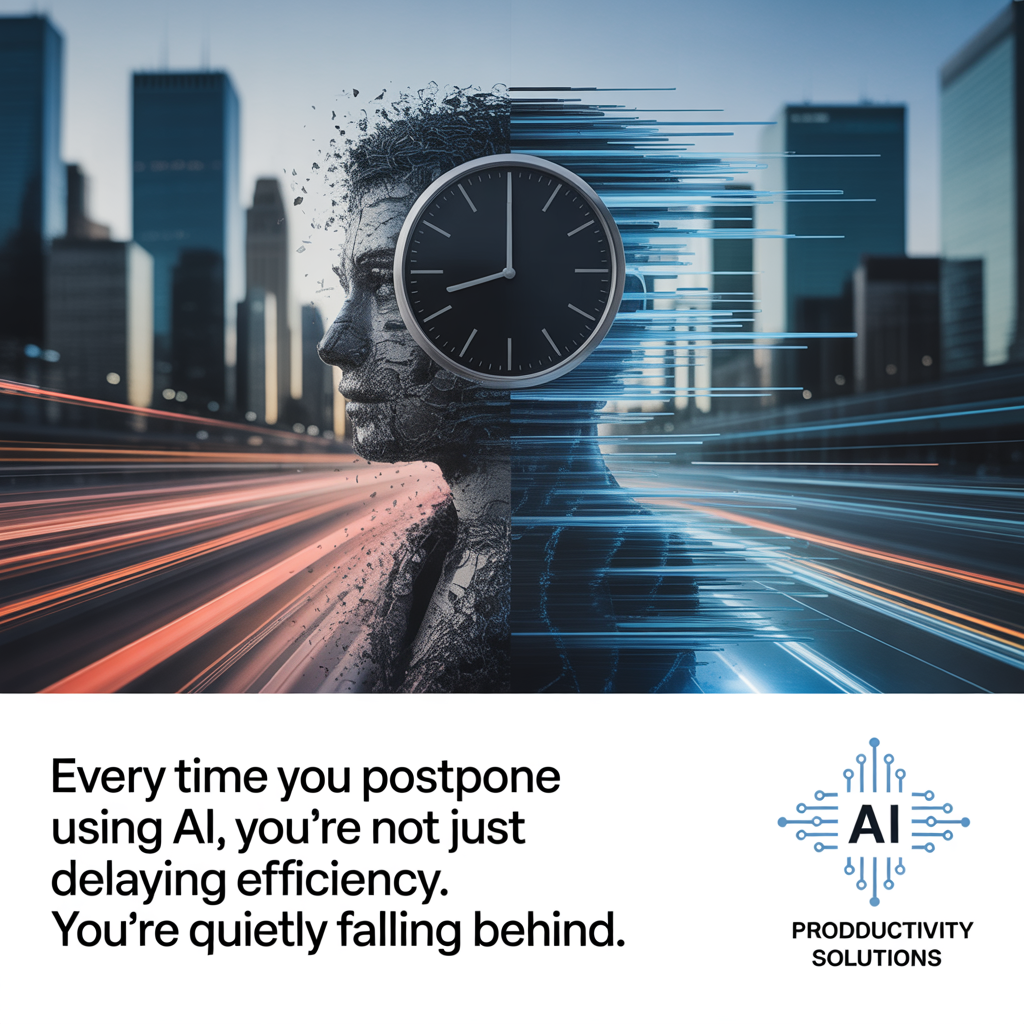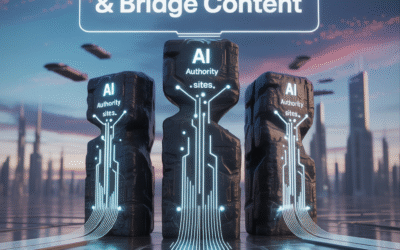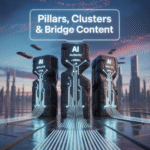The Hidden Costs of Ignoring AI in Your Industry
Every time you postpone using AI, you’re not just delaying efficiency. You’re quietly falling behind. It’s not dramatic at first. Your business still runs. Emails still go out.
Content still gets written.
But while you’re sticking to what’s familiar, your competitors are using AI to sharpen targeting, slash creation time, and respond to market shifts before you even realize they’ve happened.
That gap doesn’t close with hard work. It widens.
The hidden cost isn’t just lost time. It’s missed opportunity. AI isn’t some optional upgrade anymore. It’s infrastructure.
The businesses getting traction aren’t always the ones with better ideas.
They’re the ones using AI to test, launch, and iterate faster than the rest. If you ignore it, you’re not neutral. You’re invisible.
Because speed and relevance are the new trust signals. And if you’re still debating whether AI is worth using, you’re already behind the curve that buyers expect.
Let’s talk about content first. You’re writing a blog post. It takes you hours. You try to make it sound good, format it right, optimize it for SEO, then schedule it.
Someone else prompts AI to give them 10 content outlines based on their buyer’s pain points, selects one, asks AI to expand it, refines it, then feeds it into a content scheduling system with five social spinoffs—all in under 90 minutes.
Their post goes live first. Their content reaches your audience before you’re even done editing your intro.
Multiply that by every piece of content you create, and that gap gets wide fast.
Now let’s look at product creation. You’re brainstorming a digital course. You map it out, change your mind, start over, stall for weeks.
Someone else asks AI to summarize their audience’s biggest objections from past emails and reviews.
Then they prompt it to build a draft outline, title suggestions, and even promotional angles. They finish a sales page while you’re still stuck on module titles.
That’s not because they’re smarter. It’s because they used a tool that turns hesitation into momentum.
Then there’s marketing. If you aren’t using AI to analyze what’s working, you’re stuck with gut instinct. You “feel like” a subject line is good.
You “think” your offer is clear. Meanwhile, someone else feeds their past 10 campaigns into AI and asks which message pulled the best engagement.
Then they ask how to strengthen weak spots. Their launch refines itself in real time. Yours doesn’t.
Every campaign you run without this insight costs you reach, clicks, and revenue.
Customer experience is no different. Ignoring AI means you answer the same questions over and over.
You waste time solving problems that could be handled automatically. AI-driven chatbots, smart FAQs, and even email replies can free you to handle high-value work.
But if you avoid it because it feels “impersonal,” your customer waits longer, gets frustrated, and moves on. You’re not saving authenticity. You’re losing loyalty.
One of the most expensive blind spots is research.
A solo marketer with AI can collect, sort, and analyze competitor offers, customer reviews, niche trends, and headline formats in one afternoon.
If you skip that, you’re launching blind. You’re making decisions based on what you think people want, not what they’ve already shown they’ll pay for.
AI doesn’t just speed up research. It makes it usable. You go from guesswork to clarity fast.
There’s also fatigue. Without AI, you take longer to do everything. That means more hours, more burnout, more mistakes. You can’t scale what wears you out.
And most of what you’re doing—the formatting, organizing, rewriting, brainstorming, repurposing—isn’t the high-value stuff only you can do.
It’s the busywork AI should already be doing for you. The longer you carry that load yourself, the more likely you are to stall out completely.
Some people think the cost is just time. But it’s also morale. You start to believe you’re the problem. You wonder why it takes you so long to write an email.
Why you can’t post consistently.
Why you keep stalling out on that launch. You don’t realize you’re trying to build a modern business with outdated tools. When you start using AI properly, the fog lifts.
Things move. You feel capable again. That alone is worth it.
And here’s the kicker: buyers can tell. They may not know how you built your funnel or wrote your copy.
But they feel the difference between a business that’s clunky and one that’s sharp.
They sense when you’re lagging. Slow response times, inconsistent branding, vague messaging—it all screams “behind the times.”
When someone else can make a clearer promise, answer faster, and show up more often, they win. You lose. Not because you’re less talented.
But because they’re using leverage you refuse to touch.
So what can you do if you’ve been ignoring AI?
Start small. You don’t have to automate everything. Just pick the thing you hate most. Hate writing headlines? Prompt AI to give you 20 options for your next email.
Hate outlining blog posts?
Ask for a content brief based on your topic. Hate scheduling content? Use a tool to batch it for you. The point isn’t to replace your work.
It’s to remove the friction that keeps you from doing it.
Build one workflow. Not a whole business. Just one process where AI makes things smoother. Maybe it’s onboarding. Maybe it’s content planning.
Maybe it’s email follow-up.
Prompt:
“Build me a repeatable workflow for [task], using AI to reduce my time by half.”
Use what comes out. Then tweak it. Once it works, build another one. Over time, these workflows stack up. They become your infrastructure.
Shift your role. You’re not the worker. You’re the architect. Your job isn’t to write every word or touch every post.
Your job is to decide what matters and delegate the rest—to AI, to tools, to automation.
Prompt:
“Act as my operations manager. Help me identify which weekly tasks are wasting my time and which ones AI could own.”
Let the tool show you what you’re holding onto that you don’t need to.
Look at your blind spots. Ask AI to audit you.
Prompt:
“Based on this content, what’s missing in my messaging that could improve conversions?”
Or:
“Read this funnel and identify steps where buyers might drop off.”
If you aren’t getting feedback from someone else, let AI be the mirror. It’s not perfect. But it’s fast. And that makes it useful. Use it to test before you build.
Want to know if your product idea will land?
Prompt:
“Here’s my product concept. Create a 3-day content campaign to build interest and track reactions.”
Watch the metrics. Don’t build before you see signs. AI gives you the agility to float ideas and pivot fast. That agility protects your time and raises your win rate.
Stop thinking AI is a threat to your creativity. It’s not. It removes the drudge work so you can actually be creative. You don’t need to be in flow just to get a draft started.
You don’t need to summon inspiration for every hook. You guide the direction, let AI fill in the blanks, then shape it until it sounds like you.
The result is faster content, better ideas, and more consistency.
And remember: the goal isn’t to automate everything. It’s to stay relevant.
You can’t afford to be the person still doing it all manually while your competitors are running experiments at scale. The hidden cost of ignoring AI is momentum.
It’s missed leads. Missed revenue. Missed clarity. And eventually, it becomes missed opportunity that you can’t get back.
AI won’t save a broken business model. It won’t turn bad offers into good ones.
But it will surface what’s weak, speed up what’s strong, and give you room to improve faster than you could on your own. That’s the advantage. Not magic. Just motion.
At a time when most people are stuck in cycles of starting and quitting, showing up and ghosting, speed is the edge.
The longer you delay, the more catching up you’ll have to do later. But you don’t need to master everything at once.
You just need to decide you’re done doing it the hard way. Once you’ve made that decision, everything else gets easier.
Start now. Not with a new tool. With a new habit. Use AI today to make something easier than it was yesterday. Then do it again tomorrow.
That’s how you stop falling behind. Not by chasing perfection. By staying in motion.










0 Comments